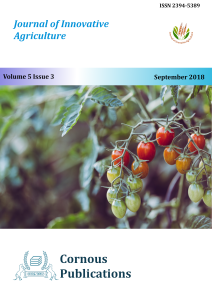Shoot and fruit borer, Leucinodes orbonalis Guene is a key pest in brinjal cultivation with yield reduction upto 89 per cent in India. Due to internal feeding behavior of L. orbonalis lessens the effectiveness and efficacy of the insecticides to the enormous level. The evaluation of integrated pest management module was conducted during Kharif and Rabi seasons of 2016 – 17. The experiment was evaluated in three treatments with ten replications comprises of IPM module, farmers practice and untreated control. The result of the experiment revealed that, the crop damage observation caused by brinjal shoot and fruit borer was measured on the basis of damaged shoots and fruits separately. The mean of shoot damage was recorded in IPM module plot of 2.21 percent, farmers practice of 15.40 percent and untreated control of 47.50 percent during Kharif season. The mean of fruit damage was recorded in IPM module plot of 3.10 percent, farmers practice of 19.50 percent and untreated control of 52.10 percent during Rabi season. In Kharif and Rabi season lowest shoot and fruit damage of 3.63 percent, 2.21 percent and 4.10 percent, 3.10 percent respectively was recorded in IPM module plot. In the present study Kharif and Rabi season recorded highest fruit yield of 288.71 and 307.50 quintals/ha and favorable cost benefit ratio of 1:2.07 and 1: 2.03 was recorded in IPM module plot.
Aflatoxins are Aspergillus secondary metabolites found in various crops and agricultural products. The contamination of food by aflatoxins can occur during crop production, processing, storage, transportation or marketing of the food products. High temperature, moisture content and water activity are among the predisposing factors that facilitate mould growth and the production of aflatoxins in food. Aflatoxins are considered the major mycotoxins produced in crops and food. In Nigeria and beyond, aflatoxin contamination is considered to be a major problem with implications that affect human and animal health as well as the economic potentials of crops. The available, updated information on the incidence of aflatoxin contamination, decontamination and its public health importance in south eastern Nigeria is lacking. The aim of this review is to highlight, update and discuss the available information on the incidence of aflatoxins in south eastern states of Nigeria. The public health implications, risk factors and the recommended strategies for control of aflatoxins in food and agricultural crops are also deliberated.
